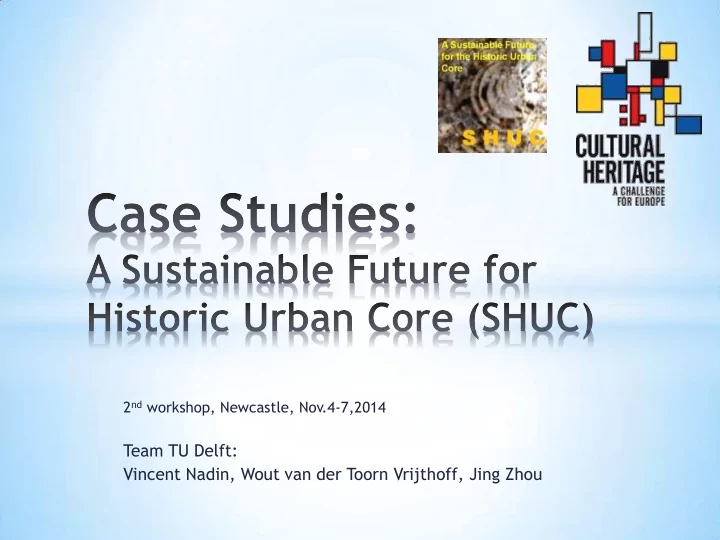

2 nd workshop, Newcastle, Nov.4-7,2014 Team TU Delft: Vincent Nadin, Wout van der Toorn Vrijthoff, Jing Zhou
Key actors and financial resources * Cultural Heritage Agency (average 50m. per year, 80m. 2014) * Local governments (main caretaker and investor for inner city) * Provincial Support Points (advising) * Federation of Monument Cities (56 partners) NGOs * National Restoration Fund (1985) * NV Stadsherstel (e.g. Midden Nederlands ’71, Breda ‘95, Den Haag ‘74)
Legal framework * Monument law (1961/ 1988) listed monuments; conservation areas * Law of spatial planning (Wet ruimtelijke ordening, 1965 / 2006) nature, function and hierarchy of structural visions and zoning plan * General Rules for Environmental Rights (Wet algemene bepalingen omgevingsrecht, 2008) management system for all physical environment-related permits a new “Environment Permit” combining about 25 types of former permits * Environmental law (Omgevingswet, 2018) to replace some 30 laws (incl.monument law, zoning plan)
Public investment * National government: permanent budget for monument care * Local government: decreasing local income from real estate development and central grants, fewer local subsidy programmes (incl. local restoration funds), little resources for new public projects Private investment * Fewer private initiatives * Active agents tend to pay less attention to the quality and cultural historic value of the new development: longer negotiation between public and private agents * People neglect responsibility for maintaining their house * Investment by rich individuals on cultural and historic heritage assets keeping money value, do good to society
Delft
Station project
Key vision after the crisis “ A vital and hospitable inner city 2020 ” (2012): promoting tourism, more possibilities for retail and cultural programmes, optimal use of space, potentials of knowledge economy Key challenges shop vacancy: average 10-15% retail functions, online shopping, crisis shrink of personnel: 15% now, 25% in 2016 Adapted approaches and innovations in management downgraded maintenance intensity for public space, do-it-together strategy to citizens from investor to director/facilitator: regular evening gathering for citizens, regular ‘Night of the Enterprises’
Adapted approaches and innovations in management Zoning plans (2002, 2012) * (Re)defining the cultural-historical values of buildings, public space and green structures (initiated by central government) * More flexibility in the plan 1. Fewer number of “anti - demolition status” buildings 2. More possibilities for permit-free building projects
Zoning plan of 2002: Functional Limitation System
Zoning plan of 2012: more flexibility Abolished FLS, simplified maps and rules, larger grouping of urban space according to the common characters Spatial grouping
Adapted approaches and innovations in management Bottom-up initiatives: entrepreneurs’ union - TvG (Between the façades), BOB Aim: * to advise local municipality on how to tackle with the shop vacancy problem * Finding new possibilities, to support new local entrepreneurs * Own financial resources: Ondernemersfonds
Bottom-up initiatives: entrepreneurs’ union - BOB Example project: Nieuwe Langendijk renovation
Key visions * HUC as heart, station area as lungs * To attract ‘quality seekers’ * Improve accessibility, liveability, safety * Core values: talent, innovative, personal and history
Key challenges * Less subsidy for heritage-related initiatives * To keep up the high level of urban renewal progress as before
Key challenges * Re-use historic buildings more actively Former post office
Adapted approaches and innovations Energy-saving programme for historical buildings * An exclusive energy fund set up by local and national restoration funds * city-image-determining buildings and monuments * Provide low-interest loan and technical support (advice and tool kit) * Installation of insulation and solar energy panels * Some 50 finished projects and 35 in development
Adapted approaches and innovations Local authority more relaxed role Linking programmes, training skills * Zoning plan: minimal fixed terms * Budget for heritage sector and programmes, no new rules declining * Make link to new subsidy * Government setting up goals and programmes for unemployment basis for common interests * Skills for renovating historical * Let the market and users execute buildings and have more decision-making power
Case study: Breda New high-speed Train station
Key vision Heritage and Visual Art as new slogan since 2008 Unique with many military barracks Over 50 religion related monuments Fairly progressive with finding new uses for monuments and historical buildings Many fusion of old and new
Flipping coins at Casino, Chasse park (former monastery)
1 st 5 star design hotel in Noord-Brabant (former monastery)
City art gallery, Chasse park (a former military garage)
Closed post-office (to be transformed into housing)
Military compounds to be transformed into public space and school
Key Vision Visual Art as a primary city marketing theme since 2008 Museum of Visual Art (MOTI) Breda’s Museum: visual guide through city history Breda Photo competition (every two years) Visual art festival (every two years)
Outdoor exhibition of photo competition at Chasse park
Key challenges * Limited investment power * 25% loss of tourists over last few years * Retail business immediately outside the city center impacted * Zoning plan in conflict with national building code
Adapted approaches and innovations Changing mindset: from a fatherly figure to a partner * Improve relation with private sectors: better communications, simplify rules, flexible zoning plan and joint programmes * Sharing responsibility for maintaining public space with business owners and citizens Create a sense of urgency for development for citizens and city politicians alike * Promoting the cultural historic value of the city * New urban projects: mix of retail and housing
New commercial project
* Changing role of the local government: from main investor to facilitator, still in experimentation, small steps, informal forms * Create room and flexibility: simplify rules in the zoning plan, new possibilities for private initiatives * Quality, integrating cultural-historical values * HUCs are used as a key engine for cultural and tourism economy, competitiveness * Busy with creating new opportunities by urban projects, moving forward
Recommend
More recommend